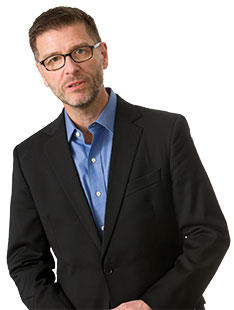Q&A: Joe Stephens: What to Read and Trust
Advice from a journalist who teaches about sources, social media, and credibility

Joe Stephens, a veteran investigative reporter for The Washington Post, has been Princeton’s Ferris Professor of Journalism in residence since 2014. His course this spring, “The Media in America: What to Read and Believe in the Digital Age,” asks students to consider the challenges and opportunities facing democracy and the freedom of the press in today’s changing media landscape. Stephens spoke to PAW about anonymous sources, fake news, and the news outlets everyone should be reading.
What should be on everyone’s “media diet”?
All news is built on three primary, central elements. First, there’s direct observation by a journalist. Second, there are identified, human sources. And finally, there are documents and data. When you’re reading, you should be looking for those to be identified — then you can evaluate how much you trust the information. That’s what we do in class.
I want my students to think about how credible the information that they’re getting is, rather than just letting it wash across them ... and I want them to think about how they’re constantly consuming media, whether they realize it or not. It used to be that if you were going to read the news, you had to go out and buy it. You had to pay for it, and you had to think, is this worth my money, worth my time? But now it’s just everywhere.
How should we evaluate unnamed sources?
Sometimes you have to have unnamed sources. But I think it should raise your antennae as a reader any time there are unnamed sources. Is it coming from a news organization that has a track record of being reputable? And does the news organization explain why they’re using only unnamed sources? Do they give you context and other reasons to back it up? Watergate, for example, had a lot of unnamed sources, but it was an important story, and it held up.
What news organizations should we all be reading, listening to, and watching?
There’s no easy answer. Some of the big legacy organizations like The New York Times and The Washington Post are doing perhaps the best work of their entire history now. ... The bottom line is that while you’re taking in the fun stuff, like Saturday Night Live and The Daily Show, you’re also making sure that you’re taking in some serious, credible information and giving some thought to putting together your own personal media diet.
You talk in your class about “iron-core” journalism — what is it?
We have this entire universe of media, but in the center of it all is a small “iron core” of hard-news reporting. There is a relatively small number of working journalists doing the hard labor of digging out the facts for everyone else to have opinions about and for everyone else to analyze. As the financial model has fallen apart in the digital age, news organizations can pay for fewer and fewer reporters to go out and do this.
When you go in-depth, you dig out hard facts that people in power often don’t want the public to know, and you go through a very laborious process of confirming the information and pulling it out. It takes a lot of time and effort, you might have to travel, and then there’s great risk — you might be sued over it. And often what we find now is that the expensive, time-consuming reporting is put up on a website for a news organization, and someone else links to it and actually gets more readers than the original story.
Almost everyone shares news in one way or another. What should we as informed citizens be doing as purveyors of news?
Before you retweet or put something on your Facebook page, actually take the time to read it. And think about where it came from — does it have transparent sources that you trust? A big part of the problem with fake news is that all of us are sharing things on our social media without first figuring out whether they’re accurate and true. People will see a headline and quickly share the article without taking the time to read past that headline. [We] need to slow down and think about what we’re doing.
Are people becoming more savvy about recognizing fake news?
I think so. A lot of problems have popped up in the last year with fake or biased news accounts, but I think people are already adapting. One sign is that over the last year, the number of subscribers of legacy news organizations like The New York Times and The Washington Post has gone up dramatically. I think this sudden increase shows that people are catching on and knowing that they need a reliable source of information. With luck, we’ll unwind this trend and wait for the next wrinkle that the internet throws at us.
Interview conducted and condensed by A.W.











No responses yet